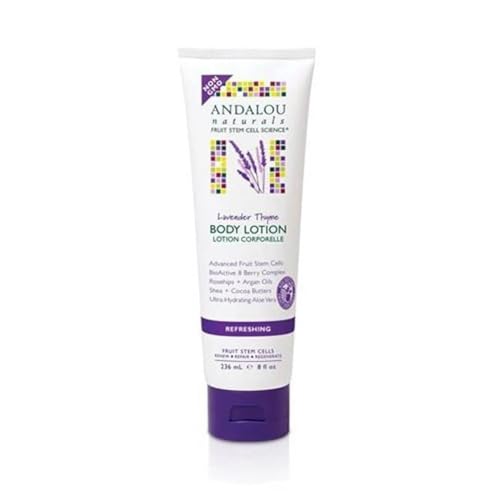
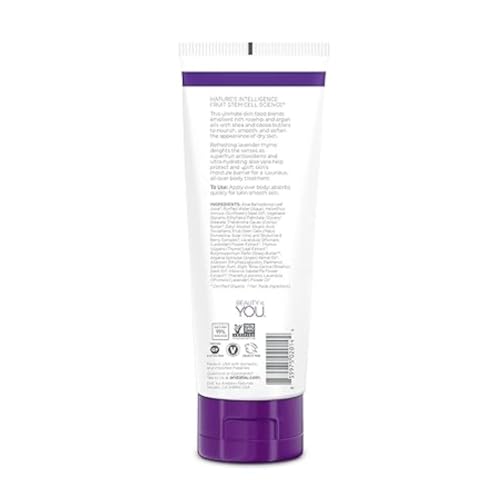
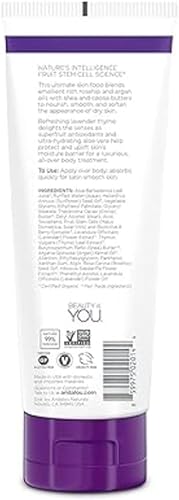
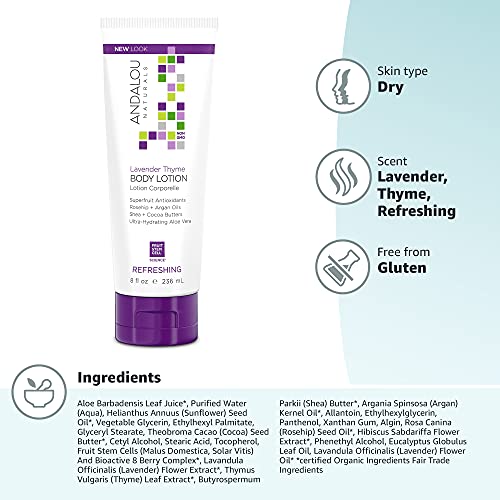
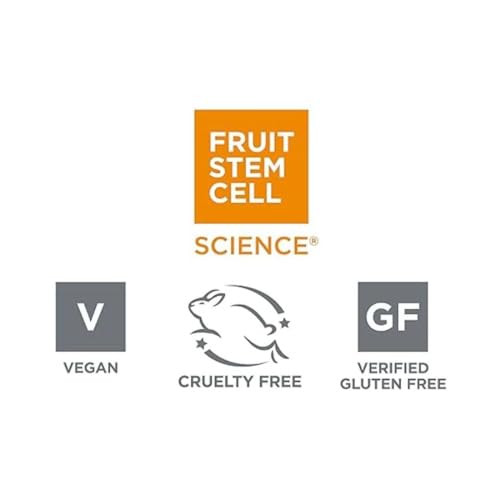

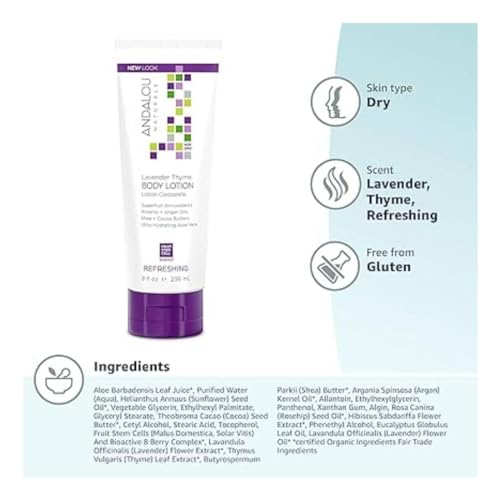
Andalou Naturals Body Lotion - Hydrates & Softens with Lavender Thyme, 8oz Organic Ingredients


Lavandula Angustifolia (Lavender)
High RiskLavandula angustifolia, commonly known as lavender, is an unspecified preparation derived from the lavender plant, primarily utilized for its aromatic properties in various cosmetic and personal care products. It is recognized for its potential role in fragrance formulation and may also possess mild soothing properties.
Sustai Insights
Lavender offers functional benefits as a fragrance ingredient and may have mild calming effects. However, it is associated with a high allergenic potential, posing risks of skin irritation or allergic reactions. Regulatory bodies do not impose significant restrictions, but the ingredient is not currently listed on skin sensitizers. Overall, the ingredient carries a high risk profile, particularly for individuals with sensitivities. Safe usage practices should be observed, with consideration for alternatives like synthetic fragrances that may reduce allergenic responses.
Phenethyl Alcohol
Medium RiskPhenethyl alcohol is an aromatic alcohol commonly used in cosmetic formulations. It functions primarily as a solvent and a preservative, contributing to product stability and enhancing the fragrance profile.
Sustai Insights
Phenethyl alcohol exhibits functional benefits as a preservative and solvent in cosmetic products, with some sustainability credentials due to its natural origin. However, it is associated with moderate allergy concerns and low risks of carcinogenicity and reproductive toxicity. Regulatory bodies have imposed specific use restrictions, highlighting the need for cautious application. Overall, the risk assessment indicates a medium risk level, warranting safe usage practices and consideration of alternatives like natural preservatives.
Algin
Medium RiskAlgin is a sodium salt of alginic acid, derived from brown seaweed. It is commonly used as a thickening agent, emulsifier, and stabilizer in various food and cosmetic products. Its ability to form gels and retain moisture makes it valuable in formulations requiring texture and consistency.
Sustai Insights
Algin provides functional benefits such as thickening and stabilizing properties in formulations and is derived from renewable marine sources, contributing to its sustainability credentials. While health risks are low regarding carcinogenicity, allergies, and reproductive toxicity, there are concerns about contamination. Environmental risks include potential pollutants and bioaccumulation. Regulatory bodies have not issued significant warnings, indicating a moderate risk level overall. Safe usage practices should be observed, and alternatives like other plant-derived thickeners may be considered for those seeking varied sourcing.
Eucalyptus Globulus (Eucalyptus) Leaf Oil
Medium RiskEucalyptus globulus leaf oil is a volatile oil derived from the leaves of the eucalyptus tree, primarily used for its aromatic properties and as a potential antimicrobial agent in various products.
Sustai Insights
Eucalyptus globulus leaf oil offers functional benefits like fragrance and potential antimicrobial properties, supporting product efficacy. However, it presents high allergenic potential and moderate irritation concerns, which may pose health risks. Environmental risks include possible pollution and bioaccumulation. Regulatory restrictions are in place regarding its use in certain products. Overall, the risk level is medium, necessitating caution in usage and consideration of alternatives like tea tree oil or peppermint oil.
Tocopherol, D Alpha
Low RiskTocopherol, specifically d-alpha tocopherol, is a naturally occurring form of Vitamin E. It is commonly used in cosmetic and personal care products primarily for its antioxidant properties, helping to protect formulations from oxidation and extend shelf life.
Sustai Insights
D-alpha tocopherol provides effective antioxidant benefits, contributing to product stability. It is sustainably sourced and generally regarded as safe, with low concerns regarding carcinogenicity, allergies, and reproductive toxicity. However, there are minor concerns about endocrine disruption. Regulatory bodies have not imposed significant restrictions, indicating low overall risk. Recommended usage practices include adhering to established safe concentration thresholds. Alternatives, such as other forms of Vitamin E or plant-based antioxidants, may also be considered.
Water
Low RiskWater is a clear, colorless liquid essential for various biological processes. It serves as a solvent in formulations, facilitating the dissolution of other ingredients and enhancing product texture and application. Additionally, water plays a crucial role in hydration and is a key component in many cosmetic and personal care products.
Sustai Insights
Water is an effective solvent and hydrator, contributing to the texture and efficacy of formulations. It is biodegradable and generally regarded as safe, with low concerns regarding carcinogenicity, allergies, and reproductive toxicity. However, excessive water usage can lead to environmental concerns, particularly regarding resource depletion. Regulatory bodies do not impose restrictions on water use in cosmetics. Overall, the risks associated with water are low, making it a safe and essential ingredient.
Ethylhexyl Palmitate
Low RiskEthylhexyl palmitate is an ester derived from 2-ethylhexanol and palmitic acid. It is commonly used in cosmetic formulations as an emollient, providing a smooth and soft feel to the skin while enhancing product texture and stability.
Sustai Insights
Ethylhexyl palmitate serves effectively as an emollient, contributing to skin smoothness and improving product formulation. It is generally recognized as having low health risks, with concerns primarily related to moderate skin, eye, and respiratory irritation. Environmentally, it poses low pollutant potential and is not bioaccumulative. Regulatory bodies have not placed significant restrictions on its use, indicating a low overall risk. Safe usage practices and alternatives like other natural emollients can be considered, reinforcing its low risk profile.
Panthenol, D
Low RiskPanthenol, also known as provitamin B5, is a humectant commonly used in cosmetic and personal care products. It functions primarily as a moisturizer, enhancing skin hydration and improving the appearance of hair by imparting shine and softness.
Sustai Insights
Panthenol is effective in retaining moisture, thus providing functional benefits for skin and hair care products. It is generally recognized as safe, with low concerns regarding carcinogenicity, allergies, and developmental toxicity. However, potential cumulative exposure from multiple sources exists. Environmental risks are minimal, and it is not bioaccumulative. Regulatory bodies have not issued significant warnings; therefore, the overall risk level is assessed as low. For optimal use, it is recommended to follow product guidelines, and alternatives such as glycerin may also be considered for moisturizing effects.
Argania Spinosa (Argan) Kernel Oil
Low RiskArgania spinosa (argan) kernel oil is a fixed oil extracted from the kernels of the argan tree, native to Morocco. It is commonly used in cosmetic formulations for its moisturizing properties, serving as an emollient and skin conditioner.
Sustai Insights
Argania spinosa kernel oil offers functional benefits such as effective hydration and nourishment for the skin and hair. It is sustainably sourced and biodegradable, contributing positively to environmental considerations. Health risks are low, with minimal concerns regarding carcinogenicity, allergies, or reproductive toxicity. There are no current regulatory restrictions on its use. Overall, it poses low risk, making it a suitable ingredient in cosmetic products. Safe usage practices should be maintained, and alternatives like jojoba oil may also be considered for similar benefits.
Helianthus Annuus (Sunflower) Seed
Low RiskHelianthus annuus (sunflower) seed is derived from the seeds of the sunflower plant and is commonly used in various cosmetic and personal care products. It serves primarily as an emollient and skin conditioning agent, providing moisture and enhancing the texture of formulations.
Sustai Insights
Helianthus annuus (sunflower) seed offers functional benefits, including skin conditioning and moisturizing properties, while being sustainably sourced and biodegradable. Health risks are minimal, with low concerns for carcinogenicity, allergies, and reproductive toxicity. Environmentally, it presents low risks of pollution or bioaccumulation. Regulatory assessments indicate no current restrictions. Overall, it is considered a low-risk ingredient, and safe usage practices should be maintained. Alternative ingredients may include other plant-based oils, but the sunflower seed oil remains a viable option.
Allantoin
Low RiskAllantoin is a naturally occurring nitrogenous compound found in various plants and animals. It is commonly used in cosmetic formulations for its soothing and moisturizing properties, as well as its ability to promote skin cell turnover and healing.
Sustai Insights
Allantoin offers functional benefits such as skin soothing, hydration, and promoting cell regeneration. It is generally recognized as safe, with low concerns regarding carcinogenicity, allergies, and reproductive toxicity. Environmentally, it poses minimal risks, being biodegradable and sustainably sourced. Regulatory bodies do not impose significant restrictions on its use. Overall, the risk level associated with allantoin is low, making it a favorable ingredient in personal care products.
Stearic Acid
Low RiskStearic acid is a naturally occurring fatty acid commonly found in animal and vegetable fats. It functions primarily as an emulsifier, thickener, and stabilizer in cosmetic and personal care products, providing texture and consistency.
Sustai Insights
Stearic acid offers functional benefits such as effective emulsification and stabilization of formulations. It is derived from renewable sources and is biodegradable, contributing to its sustainability profile. Health risks are low, with minimal concerns regarding carcinogenicity, allergies, or reproductive toxicity. Environmental risks are also low, with no significant pollutants or bioaccumulation concerns noted. Regulatory bodies, including the FDA, do not impose restrictions on its use. Overall, stearic acid is assessed as low risk, and its safe usage practices are well-established, with no significant alternatives needed.
Cetyl Alcohol
Low RiskCetyl alcohol is a long-chain organic alcohol commonly used in cosmetic formulations. It serves as an emollient, emulsifier, and thickening agent, enhancing the texture and stability of products. Cetyl alcohol is derived from natural sources, such as coconut or palm oil, and is often included in creams, lotions, and hair conditioners.
Sustai Insights
Cetyl alcohol offers functional benefits as an emollient and emulsifier, improving product texture and stability. It is biodegradable and sourced from renewable materials, contributing to sustainability. Health risks are minimal, with low concerns for carcinogenicity, allergies, or reproductive toxicity. Environmental impact is also low, with no significant pollutant or bioaccumulation potential. Regulatory bodies have not placed restrictions on its use, indicating a favorable safety profile. Overall, cetyl alcohol is assessed as low risk, and safe usage practices include ensuring proper formulation concentrations.
Xanthan Gum
Low RiskXanthan gum is a polysaccharide, a sugar-based compound produced by the fermentation of glucose or sucrose. It is commonly used as a thickening agent and stabilizer in various food and cosmetic products due to its ability to improve texture and prevent ingredient separation.
Sustai Insights
Xanthan gum serves effectively as a thickener and stabilizer, enhancing product texture and consistency. It is biodegradable and typically derived from renewable sources, supporting sustainability efforts. Health risks are minimal, with low concerns regarding carcinogenicity, allergies, and reproductive toxicity. Environmental impact is similarly low, posing no significant hazards. Regulatory agencies, including the FDA, regard it as safe for use, with no significant restrictions. Overall, xanthan gum is assessed as low risk, making it a suitable ingredient in formulations.
Ethylhexylglycerin
Low RiskEthylhexylglycerin is a glyceryl ether utilized primarily as a skin-conditioning agent and preservative in cosmetic formulations. It enhances the efficacy of preservatives and serves as a humectant, helping to retain moisture in the skin. This ingredient is commonly found in various personal care products.
Sustai Insights
Ethylhexylglycerin offers functional benefits as an effective preservative and skin-conditioning agent, contributing to product longevity and moisture retention. Health risks are generally low, with minor concerns regarding allergic contact dermatitis and irritant potential. Environmentally, it poses minimal risks, not being recognized as a pollutant or bioaccumulative. Regulatory bodies have imposed few restrictions, indicating its safety for use. Overall, its risk level is assessed as low, making it a viable option in cosmetic formulations. For those seeking alternatives, ingredients like propanediol may serve similar functions with potentially lower irritation profiles.
Hibiscus Sabdariffa (Roselle) Flower Extract
Low RiskHibiscus sabdariffa (roselle) flower extract is derived from the calyx of the hibiscus plant, used primarily for its potential antioxidant properties and as a natural colorant in various cosmetic and food products.
Sustai Insights
Hibiscus sabdariffa flower extract offers functional benefits such as antioxidant properties and natural coloring, while being sustainably sourced with low environmental impact. Health risks, including irritant potential, are minimal, and it is not classified as a carcinogen or allergen. Regulatory status is favorable, with no current restrictions. Overall, the risk level is assessed as low, making it a safe choice in formulations.
Theobroma Cacao (Cocoa) Seed Butter
Low RiskTheobroma cacao (cocoa) seed butter is extracted from the roasted seeds of the cocoa plant. It is commonly used in cosmetics and skincare products for its emollient properties, helping to moisturize and soften the skin. Cocoa butter is also known for its stability and resistance to rancidity.
Sustai Insights
Cocoa butter is recognized for its effective moisturizing properties and is sustainably sourced, contributing to its appeal in personal care products. It poses low health risks, with minimal concerns regarding carcinogenicity, allergies, or reproductive toxicity. Environmentally, it does not significantly contribute to pollution or bioaccumulation. Regulatory bodies impose few restrictions, affirming its safety. Overall, the risk associated with cocoa seed butter is low, making it a favorable ingredient in cosmetics. Alternatives include shea butter or plant oils for similar emollient benefits.
Tocopherol, D Alpha
Low RiskTocopherol, specifically d-alpha tocopherol, is a naturally occurring form of Vitamin E. It is commonly used in cosmetic and personal care products primarily for its antioxidant properties, helping to protect formulations from oxidation and extend shelf life.
Sustai Insights
D-alpha tocopherol provides effective antioxidant benefits, contributing to product stability. It is sustainably sourced and generally regarded as safe, with low concerns regarding carcinogenicity, allergies, and reproductive toxicity. However, there are minor concerns about endocrine disruption. Regulatory bodies have not imposed significant restrictions, indicating low overall risk. Recommended usage practices include adhering to established safe concentration thresholds. Alternatives, such as other forms of Vitamin E or plant-based antioxidants, may also be considered.
Water
Low RiskWater is a clear, colorless liquid essential for various biological processes. It serves as a solvent in formulations, facilitating the dissolution of other ingredients and enhancing product texture and application. Additionally, water plays a crucial role in hydration and is a key component in many cosmetic and personal care products.
Sustai Insights
Water is an effective solvent and hydrator, contributing to the texture and efficacy of formulations. It is biodegradable and generally regarded as safe, with low concerns regarding carcinogenicity, allergies, and reproductive toxicity. However, excessive water usage can lead to environmental concerns, particularly regarding resource depletion. Regulatory bodies do not impose restrictions on water use in cosmetics. Overall, the risks associated with water are low, making it a safe and essential ingredient.
Phenethyl Alcohol
Medium RiskPhenethyl alcohol is an aromatic alcohol commonly used in cosmetic formulations. It functions primarily as a solvent and a preservative, contributing to product stability and enhancing the fragrance profile.
Sustai Insights
Phenethyl alcohol exhibits functional benefits as a preservative and solvent in cosmetic products, with some sustainability credentials due to its natural origin. However, it is associated with moderate allergy concerns and low risks of carcinogenicity and reproductive toxicity. Regulatory bodies have imposed specific use restrictions, highlighting the need for cautious application. Overall, the risk assessment indicates a medium risk level, warranting safe usage practices and consideration of alternatives like natural preservatives.
Algin
Medium RiskAlgin is a sodium salt of alginic acid, derived from brown seaweed. It is commonly used as a thickening agent, emulsifier, and stabilizer in various food and cosmetic products. Its ability to form gels and retain moisture makes it valuable in formulations requiring texture and consistency.
Sustai Insights
Algin provides functional benefits such as thickening and stabilizing properties in formulations and is derived from renewable marine sources, contributing to its sustainability credentials. While health risks are low regarding carcinogenicity, allergies, and reproductive toxicity, there are concerns about contamination. Environmental risks include potential pollutants and bioaccumulation. Regulatory bodies have not issued significant warnings, indicating a moderate risk level overall. Safe usage practices should be observed, and alternatives like other plant-derived thickeners may be considered for those seeking varied sourcing.
Lavandula Angustifolia (Lavender)
High RiskLavandula angustifolia, commonly known as lavender, is an unspecified preparation derived from the lavender plant, primarily utilized for its aromatic properties in various cosmetic and personal care products. It is recognized for its potential role in fragrance formulation and may also possess mild soothing properties.
Sustai Insights
Lavender offers functional benefits as a fragrance ingredient and may have mild calming effects. However, it is associated with a high allergenic potential, posing risks of skin irritation or allergic reactions. Regulatory bodies do not impose significant restrictions, but the ingredient is not currently listed on skin sensitizers. Overall, the ingredient carries a high risk profile, particularly for individuals with sensitivities. Safe usage practices should be observed, with consideration for alternatives like synthetic fragrances that may reduce allergenic responses.
Ethylhexyl Palmitate
Low RiskEthylhexyl palmitate is an ester derived from 2-ethylhexanol and palmitic acid. It is commonly used in cosmetic formulations as an emollient, providing a smooth and soft feel to the skin while enhancing product texture and stability.
Sustai Insights
Ethylhexyl palmitate serves effectively as an emollient, contributing to skin smoothness and improving product formulation. It is generally recognized as having low health risks, with concerns primarily related to moderate skin, eye, and respiratory irritation. Environmentally, it poses low pollutant potential and is not bioaccumulative. Regulatory bodies have not placed significant restrictions on its use, indicating a low overall risk. Safe usage practices and alternatives like other natural emollients can be considered, reinforcing its low risk profile.
Panthenol, D
Low RiskPanthenol, also known as provitamin B5, is a humectant commonly used in cosmetic and personal care products. It functions primarily as a moisturizer, enhancing skin hydration and improving the appearance of hair by imparting shine and softness.
Sustai Insights
Panthenol is effective in retaining moisture, thus providing functional benefits for skin and hair care products. It is generally recognized as safe, with low concerns regarding carcinogenicity, allergies, and developmental toxicity. However, potential cumulative exposure from multiple sources exists. Environmental risks are minimal, and it is not bioaccumulative. Regulatory bodies have not issued significant warnings; therefore, the overall risk level is assessed as low. For optimal use, it is recommended to follow product guidelines, and alternatives such as glycerin may also be considered for moisturizing effects.
Argania Spinosa (Argan) Kernel Oil
Low RiskArgania spinosa (argan) kernel oil is a fixed oil extracted from the kernels of the argan tree, native to Morocco. It is commonly used in cosmetic formulations for its moisturizing properties, serving as an emollient and skin conditioner.
Sustai Insights
Argania spinosa kernel oil offers functional benefits such as effective hydration and nourishment for the skin and hair. It is sustainably sourced and biodegradable, contributing positively to environmental considerations. Health risks are low, with minimal concerns regarding carcinogenicity, allergies, or reproductive toxicity. There are no current regulatory restrictions on its use. Overall, it poses low risk, making it a suitable ingredient in cosmetic products. Safe usage practices should be maintained, and alternatives like jojoba oil may also be considered for similar benefits.
Helianthus Annuus (Sunflower) Seed
Low RiskHelianthus annuus (sunflower) seed is derived from the seeds of the sunflower plant and is commonly used in various cosmetic and personal care products. It serves primarily as an emollient and skin conditioning agent, providing moisture and enhancing the texture of formulations.
Sustai Insights
Helianthus annuus (sunflower) seed offers functional benefits, including skin conditioning and moisturizing properties, while being sustainably sourced and biodegradable. Health risks are minimal, with low concerns for carcinogenicity, allergies, and reproductive toxicity. Environmentally, it presents low risks of pollution or bioaccumulation. Regulatory assessments indicate no current restrictions. Overall, it is considered a low-risk ingredient, and safe usage practices should be maintained. Alternative ingredients may include other plant-based oils, but the sunflower seed oil remains a viable option.
Allantoin
Low RiskAllantoin is a naturally occurring nitrogenous compound found in various plants and animals. It is commonly used in cosmetic formulations for its soothing and moisturizing properties, as well as its ability to promote skin cell turnover and healing.
Sustai Insights
Allantoin offers functional benefits such as skin soothing, hydration, and promoting cell regeneration. It is generally recognized as safe, with low concerns regarding carcinogenicity, allergies, and reproductive toxicity. Environmentally, it poses minimal risks, being biodegradable and sustainably sourced. Regulatory bodies do not impose significant restrictions on its use. Overall, the risk level associated with allantoin is low, making it a favorable ingredient in personal care products.
Stearic Acid
Low RiskStearic acid is a naturally occurring fatty acid commonly found in animal and vegetable fats. It functions primarily as an emulsifier, thickener, and stabilizer in cosmetic and personal care products, providing texture and consistency.
Sustai Insights
Stearic acid offers functional benefits such as effective emulsification and stabilization of formulations. It is derived from renewable sources and is biodegradable, contributing to its sustainability profile. Health risks are low, with minimal concerns regarding carcinogenicity, allergies, or reproductive toxicity. Environmental risks are also low, with no significant pollutants or bioaccumulation concerns noted. Regulatory bodies, including the FDA, do not impose restrictions on its use. Overall, stearic acid is assessed as low risk, and its safe usage practices are well-established, with no significant alternatives needed.
Cetyl Alcohol
Low RiskCetyl alcohol is a long-chain organic alcohol commonly used in cosmetic formulations. It serves as an emollient, emulsifier, and thickening agent, enhancing the texture and stability of products. Cetyl alcohol is derived from natural sources, such as coconut or palm oil, and is often included in creams, lotions, and hair conditioners.
Sustai Insights
Cetyl alcohol offers functional benefits as an emollient and emulsifier, improving product texture and stability. It is biodegradable and sourced from renewable materials, contributing to sustainability. Health risks are minimal, with low concerns for carcinogenicity, allergies, or reproductive toxicity. Environmental impact is also low, with no significant pollutant or bioaccumulation potential. Regulatory bodies have not placed restrictions on its use, indicating a favorable safety profile. Overall, cetyl alcohol is assessed as low risk, and safe usage practices include ensuring proper formulation concentrations.
Xanthan Gum
Low RiskXanthan gum is a polysaccharide, a sugar-based compound produced by the fermentation of glucose or sucrose. It is commonly used as a thickening agent and stabilizer in various food and cosmetic products due to its ability to improve texture and prevent ingredient separation.
Sustai Insights
Xanthan gum serves effectively as a thickener and stabilizer, enhancing product texture and consistency. It is biodegradable and typically derived from renewable sources, supporting sustainability efforts. Health risks are minimal, with low concerns regarding carcinogenicity, allergies, and reproductive toxicity. Environmental impact is similarly low, posing no significant hazards. Regulatory agencies, including the FDA, regard it as safe for use, with no significant restrictions. Overall, xanthan gum is assessed as low risk, making it a suitable ingredient in formulations.
Ethylhexylglycerin
Low RiskEthylhexylglycerin is a glyceryl ether utilized primarily as a skin-conditioning agent and preservative in cosmetic formulations. It enhances the efficacy of preservatives and serves as a humectant, helping to retain moisture in the skin. This ingredient is commonly found in various personal care products.
Sustai Insights
Ethylhexylglycerin offers functional benefits as an effective preservative and skin-conditioning agent, contributing to product longevity and moisture retention. Health risks are generally low, with minor concerns regarding allergic contact dermatitis and irritant potential. Environmentally, it poses minimal risks, not being recognized as a pollutant or bioaccumulative. Regulatory bodies have imposed few restrictions, indicating its safety for use. Overall, its risk level is assessed as low, making it a viable option in cosmetic formulations. For those seeking alternatives, ingredients like propanediol may serve similar functions with potentially lower irritation profiles.
Eucalyptus Globulus (Eucalyptus) Leaf Oil
Medium RiskEucalyptus globulus leaf oil is a volatile oil derived from the leaves of the eucalyptus tree, primarily used for its aromatic properties and as a potential antimicrobial agent in various products.
Sustai Insights
Eucalyptus globulus leaf oil offers functional benefits like fragrance and potential antimicrobial properties, supporting product efficacy. However, it presents high allergenic potential and moderate irritation concerns, which may pose health risks. Environmental risks include possible pollution and bioaccumulation. Regulatory restrictions are in place regarding its use in certain products. Overall, the risk level is medium, necessitating caution in usage and consideration of alternatives like tea tree oil or peppermint oil.
Hibiscus Sabdariffa (Roselle) Flower Extract
Low RiskHibiscus sabdariffa (roselle) flower extract is derived from the calyx of the hibiscus plant, used primarily for its potential antioxidant properties and as a natural colorant in various cosmetic and food products.
Sustai Insights
Hibiscus sabdariffa flower extract offers functional benefits such as antioxidant properties and natural coloring, while being sustainably sourced with low environmental impact. Health risks, including irritant potential, are minimal, and it is not classified as a carcinogen or allergen. Regulatory status is favorable, with no current restrictions. Overall, the risk level is assessed as low, making it a safe choice in formulations.
Theobroma Cacao (Cocoa) Seed Butter
Low RiskTheobroma cacao (cocoa) seed butter is extracted from the roasted seeds of the cocoa plant. It is commonly used in cosmetics and skincare products for its emollient properties, helping to moisturize and soften the skin. Cocoa butter is also known for its stability and resistance to rancidity.
Sustai Insights
Cocoa butter is recognized for its effective moisturizing properties and is sustainably sourced, contributing to its appeal in personal care products. It poses low health risks, with minimal concerns regarding carcinogenicity, allergies, or reproductive toxicity. Environmentally, it does not significantly contribute to pollution or bioaccumulation. Regulatory bodies impose few restrictions, affirming its safety. Overall, the risk associated with cocoa seed butter is low, making it a favorable ingredient in cosmetics. Alternatives include shea butter or plant oils for similar emollient benefits.
Experience the nourishing embrace of Andalou Naturals Lavender Thyme Refreshing Body Lotion. This 8-ounce moisturizer combines nature and science with organic aloe vera and refreshing lavender-thyme for visibly healthier skin. Packed with certified organic and fair-trade ingredients, it hydrates and replenishes, making it perfect for daily use.
- Deep Hydration: Infused with organic aloe vera and sunflower oil, this lotion effectively soothes and replenishes dry skin, enhancing moisture retention.
- Natural Ingredients: Formulated with fruit stem cells and bioactive berry complex, it promotes skin renewal at the cellular level for radiant results.
- Soothing Aroma: The calming scent of lavender and thyme provides a relaxing experience, perfect for winding down after a long day.
- Eco-Conscious Choice: Certified gluten-free, non-GMO, and cruelty-free, this product aligns with your values for sustainability and ethical practices.
- Versatile Use: Ideal for daily application, it absorbs quickly for lasting softness, making it suitable for all skin types and ages.
Subscribe & Save with Sustai
- Best Price Guarantee: Always enjoy the lowest prices on sustainable home essentials.
- No Surprises: We’ll notify you before shipping. No hidden fees, ever.
- You’re in Charge: Change, pause, or cancel your subscription anytime with ease.
- Eco-Friendly Deliveries: Our grouped shipments mean less packaging and lower emissions.
Join us on a sustainable journey. Special offers for a limited time! Prices and promotions may change.
Recommended Products
Experience the nourishing embrace of Andalou Naturals Lavender Thyme Refreshing Body Lotion. This 8-ounce moisturizer combines nature and science with organic aloe vera and refreshing lavender-thyme for visibly healthier skin. Packed with certified organic and fair-trade ingredients, it hydrates and replenishes, making it perfect for daily use.
- Deep Hydration: Infused with organic aloe vera and sunflower oil, this lotion effectively soothes and replenishes dry skin, enhancing moisture retention.
- Natural Ingredients: Formulated with fruit stem cells and bioactive berry complex, it promotes skin renewal at the cellular level for radiant results.
- Soothing Aroma: The calming scent of lavender and thyme provides a relaxing experience, perfect for winding down after a long day.
- Eco-Conscious Choice: Certified gluten-free, non-GMO, and cruelty-free, this product aligns with your values for sustainability and ethical practices.
- Versatile Use: Ideal for daily application, it absorbs quickly for lasting softness, making it suitable for all skin types and ages.

You can have at most 2 Sustainable Steals products in your cart
Customer Reviews
Customers’ View
Customers appreciate the effectiveness and natural formulation of this body lotion, often highlighting its deep hydration and pleasant scent. Many users commend the moisturizing properties, describing it as very hydrating without leaving a greasy residue. A common sentiment is that it absorbs well and leaves the skin feeling soft and smooth, with one customer noting it has helped reduce the appearance of brown age spots. The natural ingredients, including organic aloe vera and sunflower oil, resonate with environmentally and health-conscious consumers. However, some customers express dissatisfaction with the pump functionality, indicating it can be unreliable. Overall, users find this product to be a quality choice that aligns well with a sustainable lifestyle.
AI-generated from the text of customer reviewsThis product has no reviews yet.




